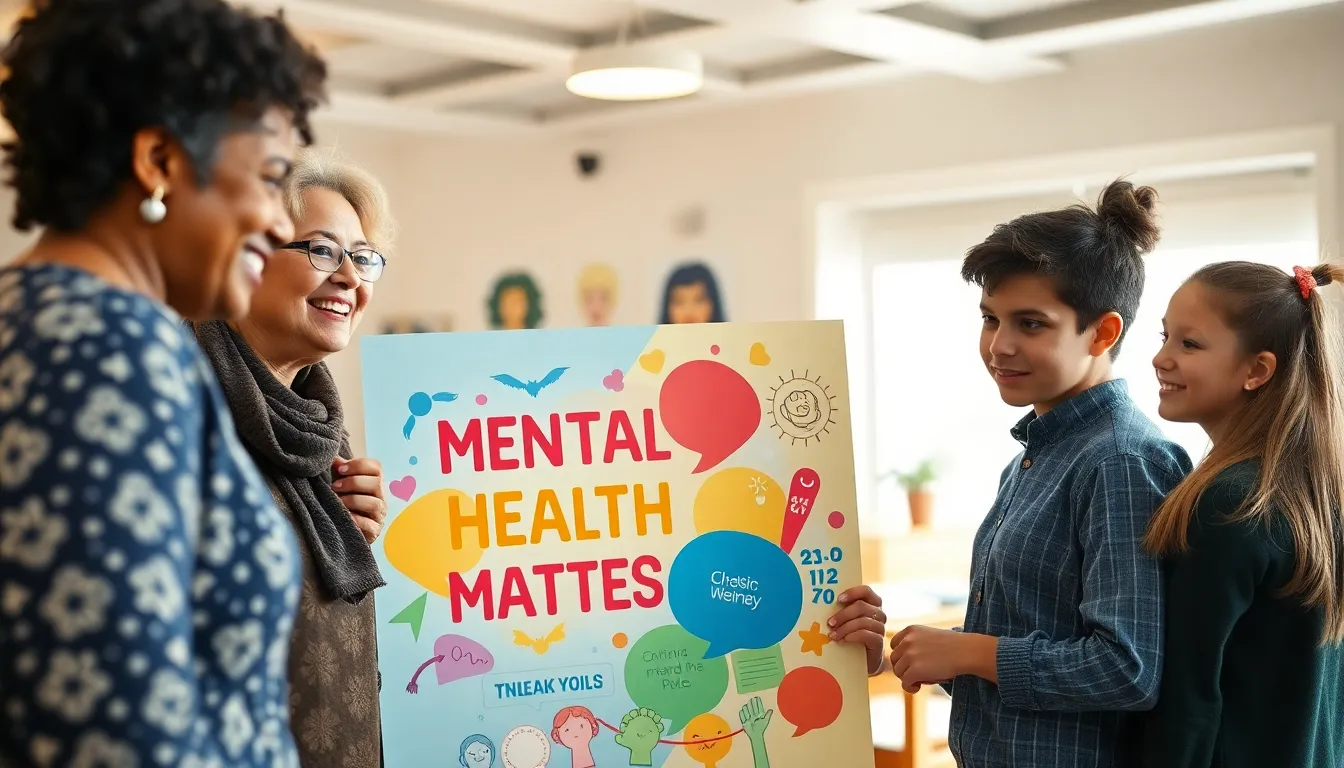In a world where stress can feel like a third wheel on a date, mental health matters more than ever. It’s time to break the stigma and embrace the conversation around mental wellness. A mental health matters poster isn’t just a piece of decor; it’s a bold statement that says, “Hey, it’s okay not to be okay.”
Imagine walking into a room and seeing a vibrant poster that sparks curiosity and invites dialogue. These eye-catching designs not only brighten up the space but also serve as gentle reminders that mental health is a priority. They encourage people to share their feelings and seek help when needed. So, let’s dive into how these posters can transform environments and foster a culture of understanding and support. After all, a little laughter and a lot of love can go a long way in promoting mental well-being.
Table of Contents
ToggleUnderstanding Mental Health Matters
Mental health holds significant value in today’s society. Recognizing its importance helps individuals understand their own well-being and the well-being of others.
Importance of Mental Health
Mental health directly influences overall quality of life. It affects daily functioning, relationships, and physical health. Research shows that one in five adults experiences a mental health condition each year. Prioritizing mental health enhances resilience and fosters emotional well-being. Individuals who focus on mental health can manage stress, relate well to others, and make more informed decisions. Encouraging open discussions about mental wellness helps combat stigma and promotes a supportive environment.
The Impact of Awareness Campaigns
Awareness campaigns play a critical role in promoting mental health. These initiatives increase understanding and provide resources for those in need. Studies indicate that communities engaging in campaigns see a rise in conversations around mental health. Awareness initiatives, such as mental health matters posters, serve to normalize discussions and create safe spaces. By visibly highlighting mental wellness, organizations foster a culture of empathy and understanding. Increased awareness can lead to early intervention and improved support, resulting in a more compassionate society.
Designing an Effective Mental Health Matters Poster

Creating an impactful mental health matters poster requires careful thought and creativity. Specific elements deserve emphasis to ensure the message resonates effectively.
Key Elements to Include
Inclusion of informative text is essential. Highlight key statistics about mental health, such as one in five adults experiencing a mental health condition annually. Brief, empowering messages also encourage individuals to seek help. Consider adding a call to action that inspires conversation about mental wellness. Ensure contact information for local mental health resources appears prominently. Visual elements, alongside informative text, contribute to a balanced design. Graphics, such as people of diverse backgrounds, humanize the message and promote inclusivity.
Color Psychology and Imagery
Choosing colors strategically influences emotions and perception. Bright colors, such as blues and greens, evoke calmness and reassurance, making them suitable for mental health themes. Incorporating warm tones, like yellows and oranges, can promote positivity and hope. Imagery adds depth to the message, representing various experiences with mental health. Including relatable visuals encourages viewers to connect with the content emotionally. Elements like nature or comforting scenes enhance feelings of tranquility. Combining effective images with thoughtful color choices maximizes engagement and retention of the message.
Tips for Distributing Your Poster
Distributing your mental health matters poster effectively increases its impact. Proper placement and targeted outreach resonate with audiences and foster meaningful conversations about mental wellness.
Target Audience and Locations
Identifying the target audience is essential for effective poster distribution. College campuses reach students grappling with stress and anxiety. Community centers engage families seeking mental health resources. Workplaces benefit from reminders about employee well-being. Public libraries serve as information hubs for diverse groups. Local businesses may display posters in high-traffic areas, capturing attention from patrons. Understanding these environments aids in maximizing outreach and ensures the poster’s message reaches those who need it most.
Utilizing Social Media and Community Events
Leveraging social media enhances poster visibility. Sharing images of the poster across platforms like Instagram and Facebook invites online discussions about mental health. Utilizing hashtags and tagging local organizations broadens reach and creates a sense of community. Attending and utilizing community events presents another opportunity for exposure. Setting up booths at health fairs or workshops creates direct engagement while distributing posters. Collaborating with mental health organizations amplifies awareness and resources. Collectively, these strategies ensure that the message about mental wellness reaches a wider audience and encourages ongoing conversations.
Success Stories: Impact of Mental Health Posters
Mental health matters posters have proven impactful in various communities across the nation. These campaigns boost awareness and promote understanding through visual communication.
Case Studies of Effective Campaigns
Campaigns integrating mental health posters into schools report increased awareness and dialogue among students. For instance, the “Talk It Out” initiative in a Texas high school involved strategically placing posters throughout the campus. Resulting from this effort, students showed a 40% increase in seeking help and discussing mental health issues with peers. Another example is a community center in California, where posters highlighted local resources. The center experienced a 30% rise in individuals accessing mental health support services after implementing this visual strategy.
Testimonials from Community Members
Community members express gratitude for the visibility that mental health posters provide. One college student noted, “Seeing the poster encouraged me to reach out for help.” Others agree on the posters’ importance, emphasizing their role in making mental health discussions more approachable. A local business owner witnessed similar changes, stating, “The posters sparked conversations in my store, helping customers feel less isolated.” Testimonials reflect collective appreciation for posters fostering a supportive environment, ultimately impacting mental wellness positively.
Mental health matters posters play a vital role in promoting awareness and fostering supportive environments. By encouraging open dialogue and prioritizing mental well-being, these posters help break the stigma surrounding mental health. Their strategic design and placement can significantly impact communities, inspiring individuals to seek help and connect with resources.
As society continues to recognize the importance of mental health, initiatives like these serve as essential tools for change. They not only enhance physical spaces but also cultivate a culture of understanding and compassion. Embracing such visual prompts can lead to a brighter future where mental wellness is prioritized and openly discussed.




